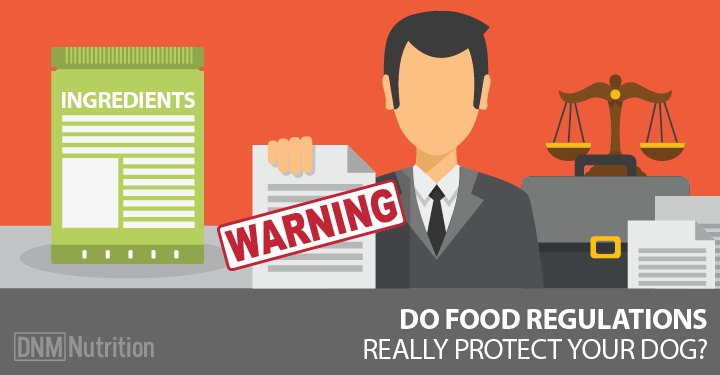The Association of American Feed Control Officials (AAFCO) and the Food and Drug Administration (FDA) are responsible for various aspects of dog food standards, including allowable ingredients, labeling, nutrient standards and food safety. It’s nice to think that these pet food regulatory bodies are looking out for your dog’s safety and health.
You want to feed your dog a “complete and balanced” food, and you rely on the manufacturer’s compliance with AAFCO standards to be sure your dog’s getting all the nutrients he needs. The FDA’s role is to assure that your pet’s food is safe to eat, free of contaminants and truthfully labeled.
So between the two, we’re covered, right?
Well … maybe not.
The Cornucopia Institute, a public interest group that researches and investigates agricultural and food issues, has produced a new report on pet food. In this report, they explain how regulatory loopholes allow some pet food makers to get away with using ingredients you might not want your dog to eat.
“Premium” = Quality
Not really. Unfortunately, terms like “premium,” “healthy,” and “holistic” are meaningless when it comes to the regulations.
According to AAFCO’s Official Publication, pet food labels may include “an unqualified claim, either directly or indirectly” and there’s no requirement for this type of claim to be backed by any scientific data.
So when the manufacturer tells you their food is “premium,” or uses other broad descriptions intended to make it sound high quality, remember it’s just a marketing term and doesn’t necessarily mean the food is any better quality than another.
In fact, it’s illegal under AAFCO rules for the manufacturer of a truly high quality pet food to label its ingredients in a way that distinguishes the food from lower quality foods.
So, if you want to choose a food that uses human grade ingredients like USDA-approved meat (instead of feed grade meat that can include meat that’s expired, diseased or contaminated with drugs) … you won’t be able to identify the human grade ingredients by reading the ingredient label, because that distinction isn’t allowed on the ingredient statement.
The manufacturer is allowed to provide the information elsewhere on the label, but you’ll have to work a bit harder and read everything on the package, not just the ingredient label, to find out; you may even have to visit the company’s website, or call them and ask them if they’re using USDA inspected and approved meats.
Don’t Be Fooled!
If they say the meat is from USDA-inspected facilities … that doesn’t mean the meat itself has been inspected or approved! Read more about this sneaky language here.
[Evaluate Your Pets Food At Home] Want to make buying the right food for your pet easier? Click here to read our post all about evaluating your pet’s food. We have simple tools and tricks you can use right now to know whether your pet is getting the essentials he needs out of his food!
Non Slaughtered Meats
The Food Drug and Cosmetic (FD&C) Act regulates human and pet food, monitored by the FDA. Under these regulations, “poisonous, unsanitary or deleterious ingredients” or products of a “diseased animal” or an “animal that has died otherwise than by slaughter” should not be in your dog’s food.
The loophole …
The Compliance Policy Guides (CPG) for the FD&C Act acknowledge that canned pet foods not only use rendering industry products like meat, poultry and bone meals, meat scraps from packing house waste, but also “meat from animals that may have died otherwise than by slaughter.”
The CPG goes even further by making an exception for pet foods, stating that no regulatory action will be taken in these cases, “provided they are not otherwise in violation of the law.”
So, apparently, there’s really nothing stopping manufacturers from using products from animals that have died otherwise than by slaughter in your dog’s food. This could include road kill as well as sick or diseased animals.
How Bad Is It?
It’s pretty bad.
For one thing, the FDA has found the euthanasia drug sodium pentobarbital in at least 30 different pet foods. There’s no testing required, and short term feeding studies show liver damage at low doses. The long term effects of sodium pentobarbital consumption are unknown. Watch out for animal fat as well as meat and bone meal in your dog’s food … foods with these ingredients may be more likely to contain this drug.
For another, while it’s often denied by the industry, there are verbal and written testimonies to the fact that some pet foods may contain cat and dog meat from animal shelters. Investigations have shown that dead animals are picked up from shelters and taken to rendering plants.
Adding to the grisly intrigue, the two largest companies that pick up carcasses from shelters and clinics just happen to be owned by rendering companies. You can’t help being suspicious…
There’s no way to test pet foods for different animal species …
… the high temperature rendering process destroys DNA.
Individual state regulations vary but may allow rendering plants to use road kill, restaurant grease and spoiled meat. Diseased animals may also be in your dog’s food. While the FDA says that cows that are unable to walk or show other signs of disease are not allowed in human food, the CPG allows them in pet food.
A Bad Trade-Off
Part of the reason adulterated meats are allowed in pet and animal feed is economic, due to the high cost to livestock producers of disposing of dead animals, as well as potential lost sales by the rendering industry. There are also environmental and public health concerns associated with disposing of these animals in landfills.
But the Cornucopia Institute makes the excellent point that, despite the environmental challenges, it’s not an ethical solution to put this material into pet and animal foods “to increase the profitability of rendering plants, livestock producers and pet food companies” … and of course we agree. Our pets shouldn’t have to pay the price with their health.
How To Avoid These Ingredients
The best way to be really safe is to feed your dog a home prepared diet, so you know exactly what’s in it. A whole foods based diet, preferably raw, will help ensure your dog isn’t eating diseased or contaminated animals. Here’s a raw feeding primer to get you started.
If you’re feeding commercially produced dog food – whether kibble or canned, or in some cases, even raw – it’s very hard to know what kind of meat is in it, unless the manufacturer chooses to disclose this information. Read the company’s website to find out how their ingredients are sourced, or call them to ask if all their meat ingredients are USDA approved.
Responsible companies who are using high quality ingredients will almost certainly describe their sourcing of meat and other ingredients at length on their websites …
… so if the information isn’t there, be wary.
One very large manufacturer’s website I looked at includes lots of cleverly written but very non-specific information about ingredients, while managing to completely avoid saying where their meat comes from.
You can also review the Cornucopia Institute’s Pet Food Guide, which provides information on many brands.
Footnote: we’re sometimes asked about Canadian pet food regulations. The answer is that they’re very minimal.













